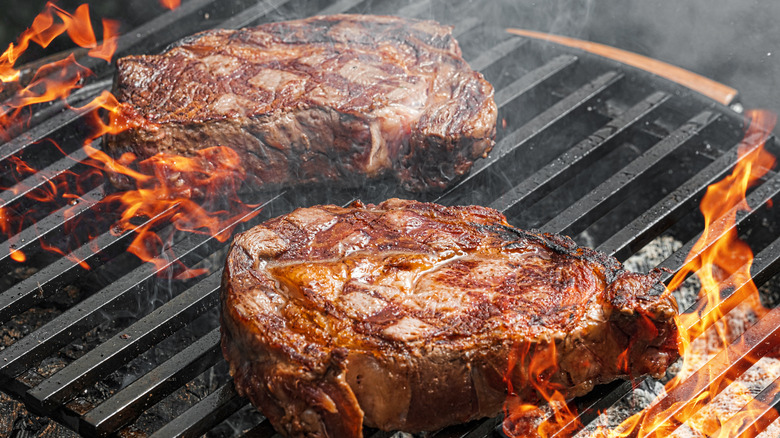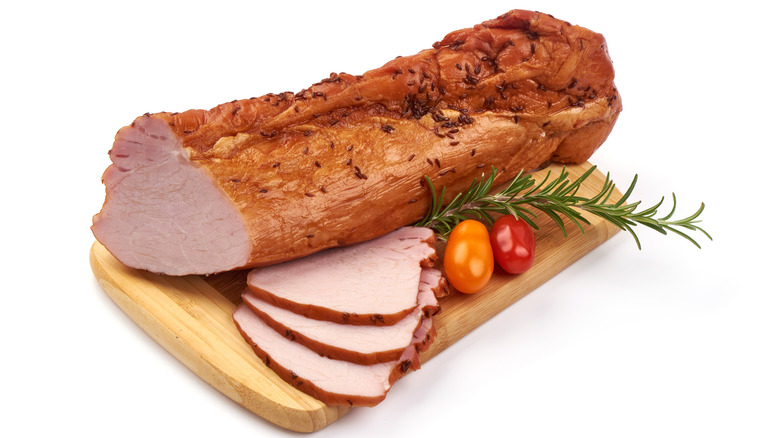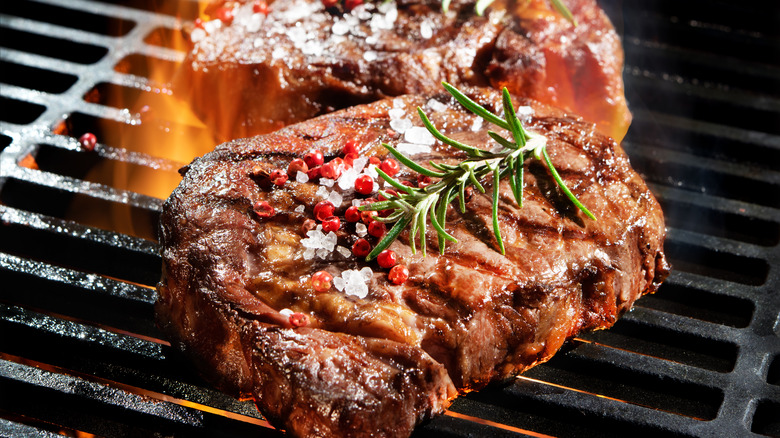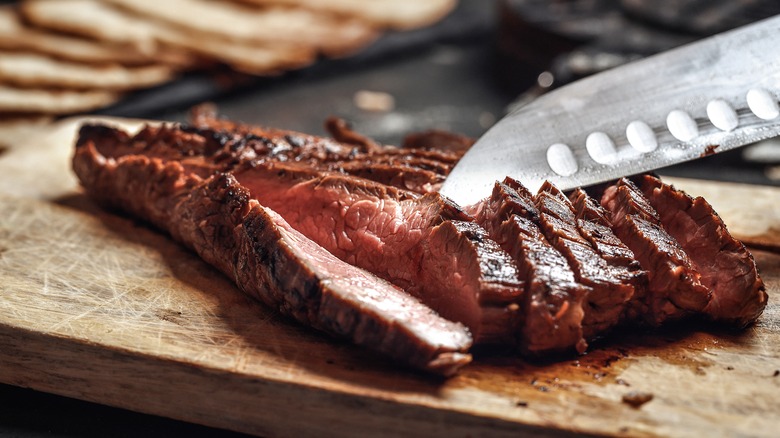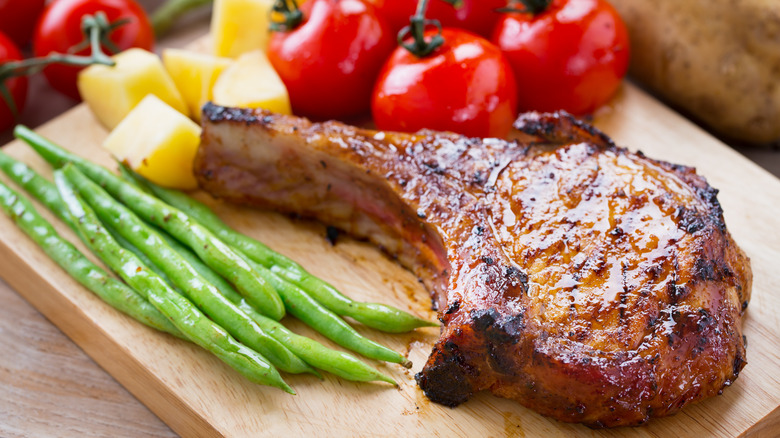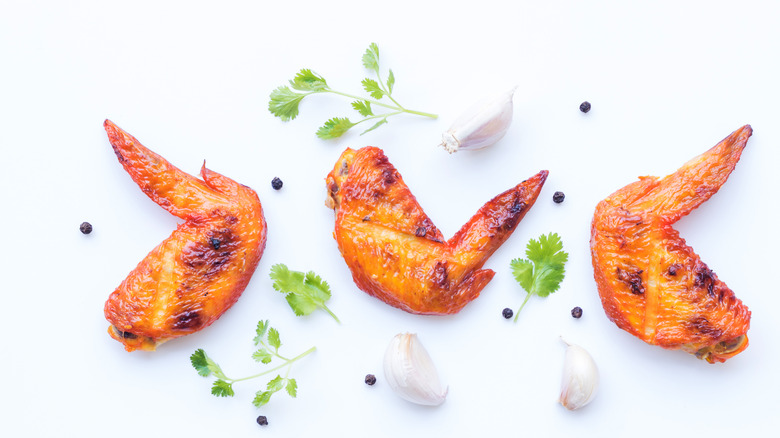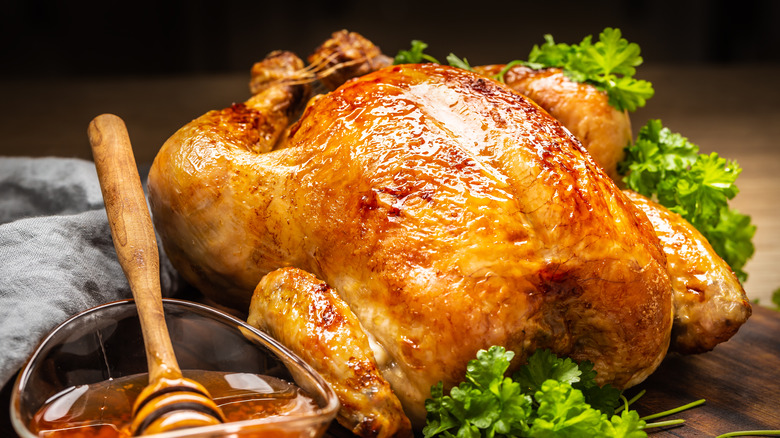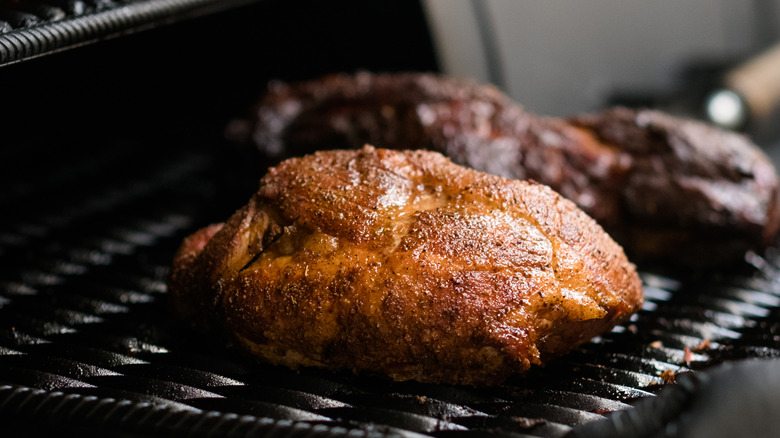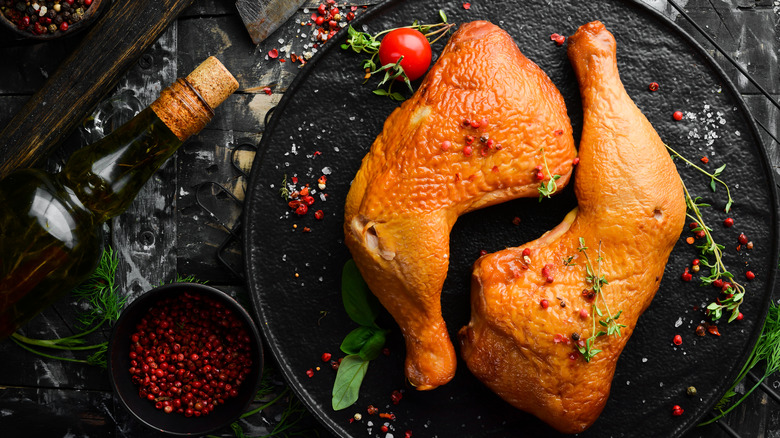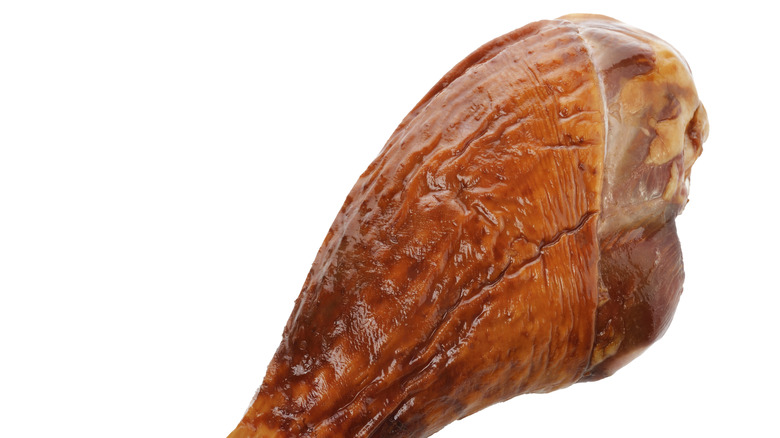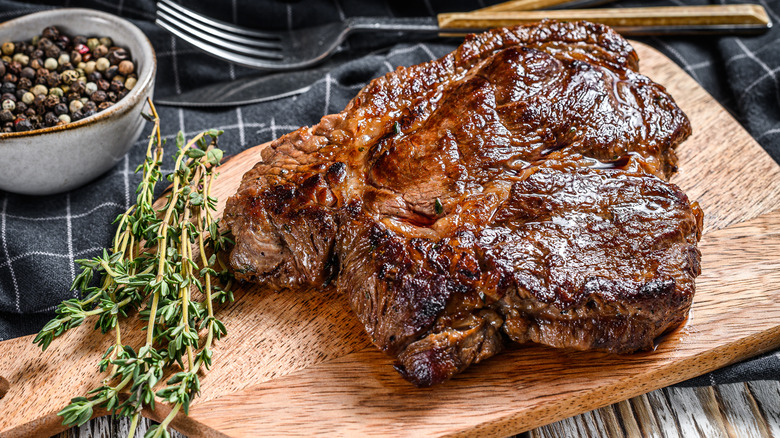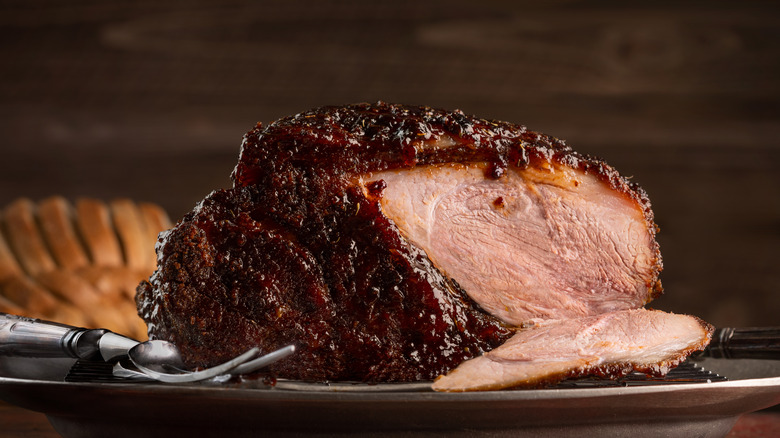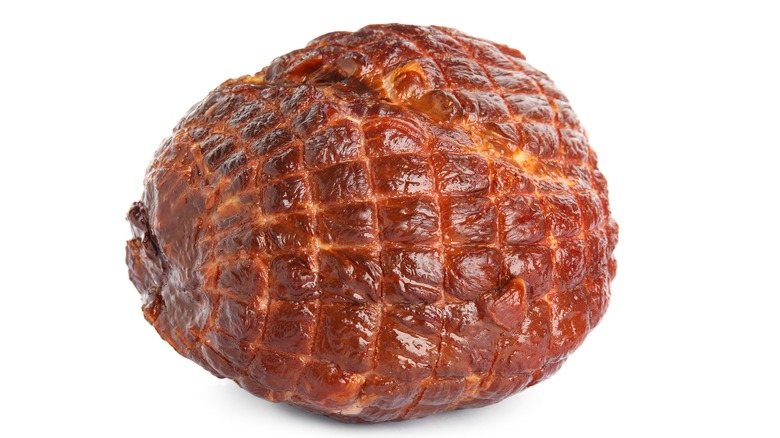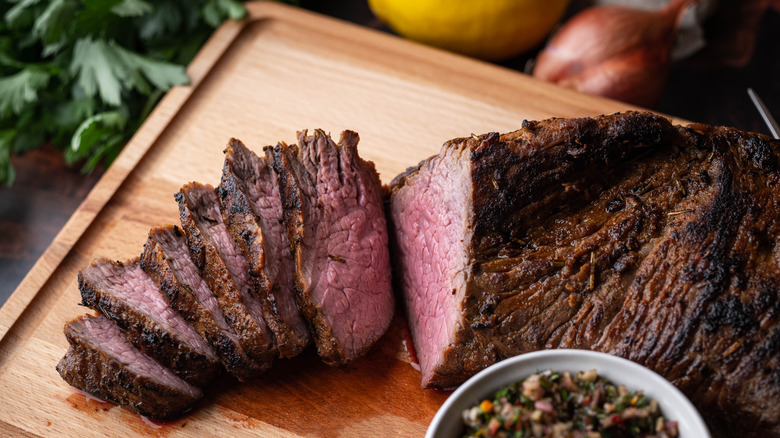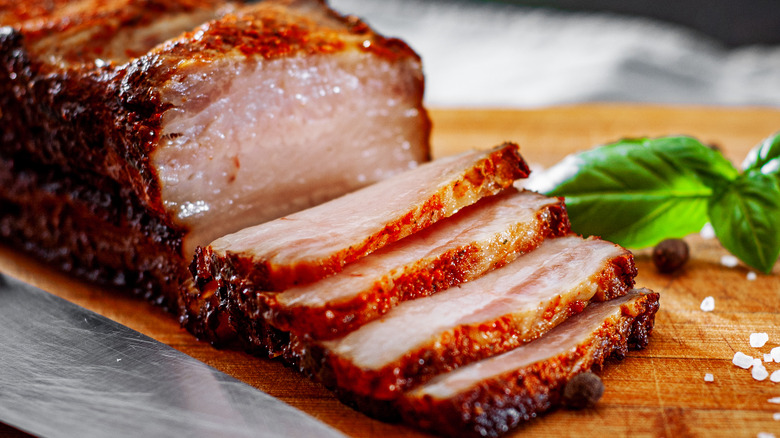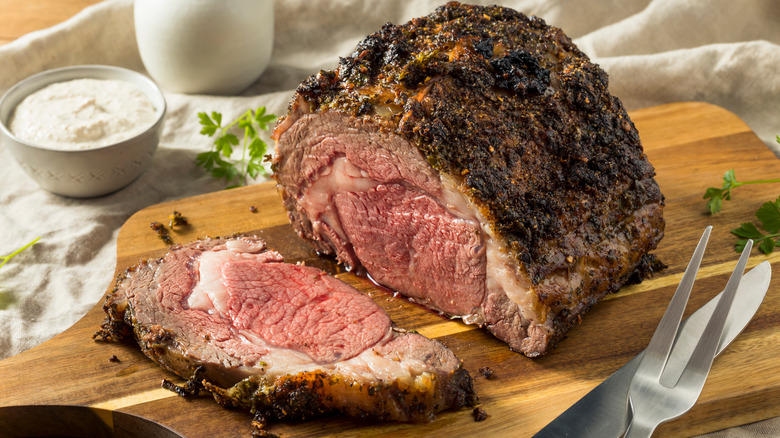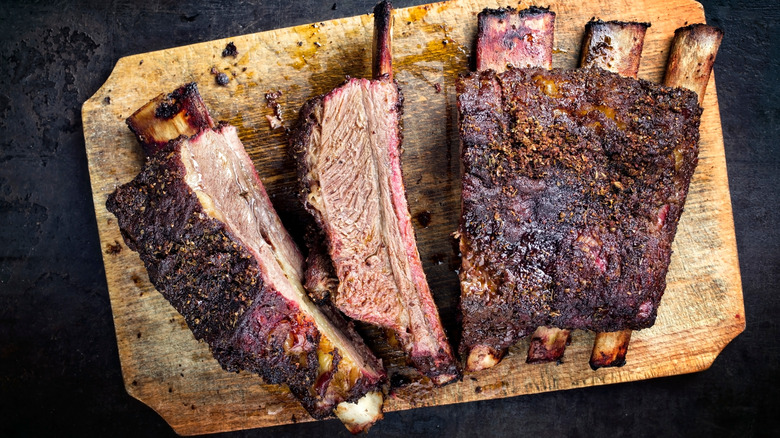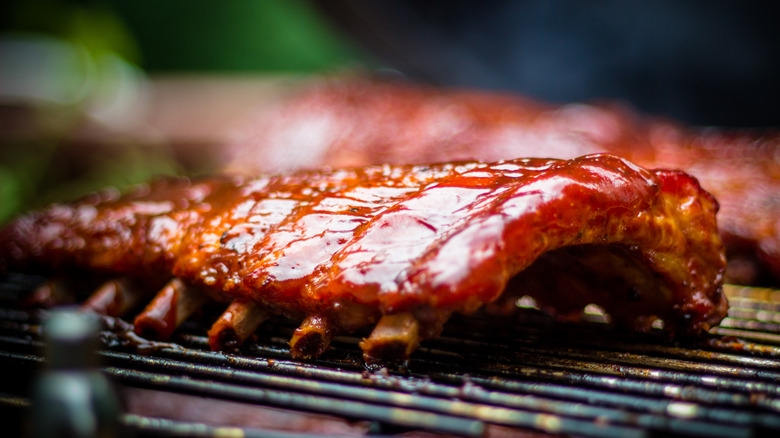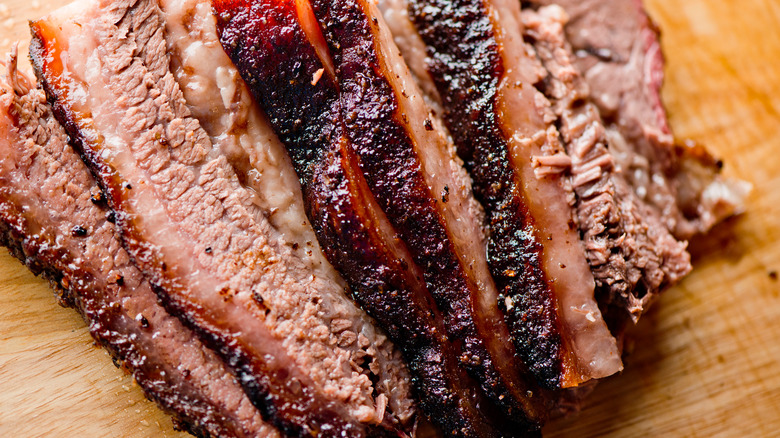Ranking 18 Cuts Of Meat To Smoke, From Worst To Best
When the temperatures get warmer, outdoor grilling and smoking are essential parts of parties, picnics, and backyard barbecues. Grilling may be a more popular technique, but smoking is an arguably better method. The relatively low heat of the smoker cooks meat more evenly and avoids excessively charring your food. Also, you can spend more time sitting back and relaxing or mingling with your cookout guests instead of hovering over a hot grill.
But above all, the greatest benefit of using the smoker is in the name: the closed lid during the cooking process imparts a deep, rich smokiness that compliments almost every cut of meat. That being said, some different proteins and different cuts work better than others. Some cuts will shine on your smoker, while others will smolder. That's why we ranked different cuts of meat to smoke from worst to best, so you can be the pitmaster of your own barbecue at your next gathering.
18. Pork tenderloin
Pork tenderloins are found underneath the backbone of the hog. The muscles don't get much use which makes for lean meat without any intramuscular fat. What pork tenderloin lacks in fat content it makes up in tenderness. It's quick-cooking and perfect for roasting in an oven, but for smoking, it's best to look elsewhere.
The lightness and tenderness that make pork tenderloin so delicious are lost in the slow cook of the smoker. In the time it takes for the meat to develop the desired smokiness, it will lose most of its moisture. Instead, you'll be left with a tough, dry piece of meat that no amount of sauce can salvage. Next time you're planning to cook a pork tenderloin, stick to the stove or the oven. You are better off smoking a cut of pork with more fat and connective tissue to keep the meat tender and juicy.
17. Beef tenderloin
It's not a coincidence that you rarely, if ever, see smoked beef tenderloin on a restaurant menu. You're more likely to see it seared to a medium-rare perfection at a steakhouse rather than on a tray of barbecue. This cut of meat is one of the most expensive cuts on the cow and is beloved for its buttery soft texture when cooked well.
Just like its pork counterpart, beef tenderloin does not have enough fat to withstand the dry, circulating air of the smoker. As this meat passes the temperature for medium-rare (around 135 degrees Fahrenheit), it will become increasingly tough and leathery. Because of the smoker's relatively low heat, this piece of equipment is better suited for meat that can cook for long periods of time. And for the price you'll pay for this cut of meat, you'll get a better bang for your buck cooking it on the stove.
16. Flank steak
Flank steaks are sourced from, naturally, the flank area of the cow. This cut, found just below the loin, is fairly lean with lots of deep, beefy flavor. Making sure a flank steak is tender, however, takes a bit of finesse. There are a lot of factors to consider when making a perfectly cooked flank steak. Ensuring the internal temperature remains around 135 degrees Fahrenheit and slicing the steak against the grain will highlight all of its best qualities.
The finicky flank steak typically stays the juiciest when cooked quickly. Because of this, the low and slow smoker is not the ideal tool to use when preparing a flank steak. Flank steaks can become especially rubbery when overcooked, which is a big risk when using the smoker. Instead, you can turn to the strong flames of a grill for a better result. You can still obtain a light smoky flavor by cooking it over direct heat without sacrificing the texture.
15. Pork chop
A pork chop is a slice of pork loin attached to a rib. The bone is partially covered in a layer of fat that brings flavor and moisture to the otherwise lean cut of meat. In addition, the bone insulates and protects the surrounding meat, which gives you a bit more wiggle room to cook a pork chop without overcooking it.
Just like with whole pork tenderloin, pork chops are best cooked over direct heat for eight to 12 minutes. The hot circulating air of the smoker will dry out a pork chop before it imparts enough smoky flavor. The bone will help slightly to prevent overcooking, but the smoker is still not the ideal way to cook a pork chop. While the area around the bone with more connective tissue and fat will be tender and delicious, you will encounter issues with dryness and toughness with the loin. You are better off cooking the ribs on the smoker on their own than using the whole chop.
14. Chicken wings
Chicken wings are a fan favorite at any party or barbecue. You may be used to seeing them battered and fried with a healthy amount of hot sauce, but you can smoke chicken wings for a delicious appetizer. Because of the bone and lots of natural fat, this meat stays unctuous and juicy even in a smoker.
One drawback to smoking chicken wings is their size. Each chicken wing has a small amount of meat on the bone compared to other cuts of meat, so it's easy to burn them and dry them out if you are not careful. If you're planning on making smoked chicken wings on a busy day, it is advisable that you enlist someone to keep an eye on the chicken wings. Otherwise, it might be smarter to just call your favorite chicken wing restaurant to make the chicken wings for you and save yourself the trouble.
13. Whole chicken
Chicken is a staple protein that can taste great when smoked, which is why you see it frequently on barbecue menus. Some cuts, however, are too dry and delicate to hold up to the intensity of the smoker. This poses a problem for smoking a whole chicken, which has multiple different types of meat. White meat in particular does not tolerate prolonged cooking methods well compared to darker meat.
By the time the chicken thighs and legs are tender, the breasts may be dry and the wings will be almost completely burnt. The process of smoking will sacrifice the juiciness of nearly half of the chicken and essentially waste it. You can supplement the chicken with brine or even a can of beer, but you are still better off breaking the chicken down and cooking its parts individually to ensure that each piece is cooked to perfection, rather than relying on the smoker to cook a whole bird.
12. Turkey breast
Turkey breasts are mainstays in deli sandwiches and on Thanksgiving tables, but did you know that they taste great in a smoker too? Turkey can often get a bad rap for lacking flavor. When you smoke it, however, the smoke highlights the delicate flavor of the meat while adding some extra nuance. While white meat generally does not fare well under the dry, circulating heat of the smoker, turkey breasts on the bone are large enough and have the protection of the bone to keep it relatively juicy when cooking it this way.
Because of the low fat content of turkey breasts, it is advised that you brine the bird before hitting the smoker. That way, it will maintain more of its moisture while it cooks. Next time you are looking to spice up a holiday dinner, try turning to a smoker to add some extra flavor to a delicately flavored turkey breast.
11. Chicken thighs
Chicken thighs are among the most versatile cuts of meat on a chicken and in general. The dark meat stays juicy with quick-cooking techniques but retains its tenderness when cooking it low and slow. You can find chicken thighs on menus in almost every type of preparation. They are deliciously grilled, braised, and seared — but they are especially tasty when cooked on a smoker.
The smoker is a great way to add flavor without sacrificing quality with chicken thighs. Like with most cuts of meat, they are best cooked with the bone in and the skin on, to protect the meat and add more delicious fat. The final result will be melt in your mouth chicken with a rich smokiness and a crisp skin —making it a perfect cut to start with when experimenting with a smoker. With just a bit of barbecue sauce, you will have a dish that rivals many professional restaurants.
10. Turkey leg
There is a good chance you can find smoked turkey legs at your local amusement park. The smell of smoked turkey can draw long lines at outdoor food stands— and for good reason. Turkey leg is one of the most flavorful parts of the bird and can take on tons of smoky flavor. When you want to satisfy your carnival craving at home, turkey legs are easy to make in your own backyard.
The connective tissue throughout the leg needs plenty of time to break down, so the long, slow cooking of the smoker is a great way to ensure soft, tender meat. Meanwhile, the exterior develops a smoky, crackly crust that amps up the flavor even more. The crispy rendered fat on the skin of a turkey leg helps to keep the meat extra moist as well. Cooking smoked turkey legs at home is an almost foolproof process that can transport you to your favorite theme park without a ticket.
9. Chuck roast
A chuck roast is taken from the shoulder of a cow, where the muscles are constantly moving. Because it comes from an active part of the animal, there is a considerable amount of connective tissue and intramuscular fat (what you may know as marbling). Cooking this cut of meat like a steak will leave you with chewy meat with lots of undercooked fat.
These need lots of time to break down, and once they do, you are left with fork-tender, melt-in-your-mouth meat. This makes it a perfect candidate for a smoker, since the meat gets more and more tender as it smokes. The smoke also augments the naturally beefy flavor of a chuck roast. An added bonus: this meat is relatively inexpensive but can taste better than a more expensive cut with the right cooking method. You can also smoke more meat at once and keep leftovers for future cooking projects.
8. Pork shoulder
Sometimes labelled as Boston Butt, the pork shoulder is an inexpensive cut of meat that is well worth the price if you cook it well. Just like the chuck roast of a cow, the pork shoulder comes from the same part of the animal. It is also tough, but full of meaty flavor. There is a large amount of fat dispersed throughout the muscle and lots of tissue that breaks down into rich, tasty collagen.
If you smoke a pork shoulder low and slow, the meat will tenderize and eventually become fork tender. This preparation is perfect for pulled pork sandwiches or a batch of smoky carnitas to put in a taco. Try to find a bone-in cut when using the smoker so you can incorporate even more flavor. Pork shoulder is a versatile, inexpensive cut of meat that tastes good with almost any flavor combination, making it a perfect addition to a backyard barbecue.
7. Ham
Another fixture on the holiday table is a whole ham. A ham comes from the leg of a pig and is cured with salt, either in a dry rub or a wet brine. You can often find them pre-smoked at your local grocery store, but if you want to earn extra points at dinner, try smoking it at home yourself.
Because of the brining process, hams retain more moisture and are seasoned from the inside out. That combined with the naturally dark, moist meat makes it nearly foolproof to cook in a smoker. It lends well to long, slow heat application, so a smoker will give you the perfect texture to complement its rich flavor. The exterior of the meat will turn a deep golden brown and retain a nice crispness that surrounds delectable, melt in your mouth meat. All you need is a homemade glaze to give the grocery store a run for its money.
6. Tri-tip
Tri-tip, named after its triangular shape, is a cut of meat found at the bottom of the sirloin of a cow. This cut has a moderate amount of marbling and lots of beefy flavor that is amplified in the smoker. That is why you can often see it at barbecue restaurants, either piled high on a sandwich or on a tray of other smoked meat.
The low and slow heat of smoking tri-tip allows for even cooking of the whole roast. Once cooked to medium rare, this steak is juicy, tender, and full of smoky flavor. While you should not cook tri-tip for as long as you would a chuck roast, the tri-tip is large enough to take on smoky flavor without overcooking. Make sure you give it plenty of time to rest after you take it out of the smoker, so it can retain as much moisture as possible and stay juicy.
5. Pork belly
Pork belly comes from, you guessed it, the area around a pig's stomach. This cut of meat has thick layers of fat with minimal meat. It is commonly seen fried into bacon strips at breakfast, but you can smoke pork belly at home for a decadent dinner that will seriously impress your friends and family.
Because of the large amount of fat, you need a lot of time to properly render it and allow it to melt into the meat. Otherwise, you will end up with lots of chewy fat that is fairly unpleasant to eat. To combat this, turn to the smoker, which will slowly draw out the fat while evenly crisping the exterior. While it will remain fatty no matter what, the smoker will make it enjoyable to eat and add some extra flavor. You will end up with a rich, succulent piece of pork that is perfect for special occasions.
4. Prime rib
A prime rib roast is taken from the upper ribs of a cow where there is plenty of fat and marbling. This meat is incredibly juicy and tender, and needs a long cooking time because of the sheer size of the roast.
The smoker is a great tool to use when you want to slow cook a prime rib while adding a hint of smokiness. The fat has plenty of time to melt into the meat and add even more moisture while the outside develops an incredible char. It should stay closer to medium rare in the center while taking on plenty of smoke. A smoked prime rib is a perfect centerpiece for a large gathering because it can feed a lot of people and is a definite crowd-pleaser. Served with a side of spicy horseradish sauce, a prime rib is one of the best meats to place in an outdoor smoker.
3. Beef ribs
The meat around beef ribs is generally tougher, but full of flavor because of their proximity to the bone and the hearty amount of fat and collagen. Smoking is a classic way of preparing beef ribs because of their tender meat after a long cooking time and the intense flavor that highlights the natural taste of the beef.
Beef ribs are easy to smoke at home as long as you give them enough time to break down. One part of the ribs that will not break down is the membrane lining the rib cage, so be sure to remove that before cooking so people won't have to chomp down on anything too chewy. The rest of the meat will recede from the bone and soak up all of the smoky flavor, making it an easy treat to eat with your hands. Serve them with a dry rub, barbecue sauce, or both, and prepare to win over the whole family.
2. Pork ribs
Pork ribs are one of the most common offerings at barbecue spots all over the country, and for good reason. Each bite is bursting with savory flavor and richness, and becomes even more tender the longer they cook. Because of this, slow cooking them in a smoker is the ideal way to prepare pork ribs. Add in some flavorful spices and sauces, and you will have the most popular dish at the cookout.
Baby back ribs are generally more tender and lean, so they require slightly less cooking time than the tougher, but more flavorful spare ribs. When the meat breaks down in the smoker, it becomes rich and unctuous, and can fall right off the bone if cooked long enough. No matter which type of ribs you choose to use or how you choose to season them, the smoker is guaranteed to take your pork ribs to the next level for your next barbecue or family gathering.
1. Brisket
The quality of a barbecue restaurant is often judged by its brisket recipe. No matter where you go, you're almost guaranteed to find brisket somewhere on a barbecue restaurant's menu. This cut of meat is found underneath the chuck of a cow and has a lot of tough connective tissue to break down. It's typically an inexpensive cut of meat, but a smoked brisket is worth its weight in gold.
With the low, indirect heat of the smoker, the brisket has plenty of time to become melt-in-your-mouth tender. Meanwhile, the layers of fat around the outside render and soak the meat with more flavor. When cooked properly, beef brisket should develop a pink smoke ring around the exterior of the meat. It takes a lot of finesse to perfect a recipe for beef brisket, but cooking it in the smoker is your safest bet to have the juiciest, most delicious meat possible.
